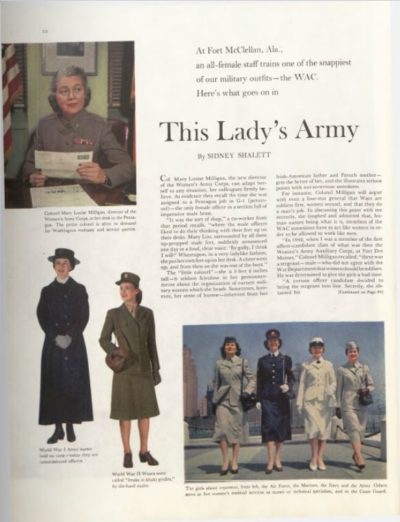Women in the Military: A 75-Year Evolution
Today, the idea of women serving in the military is widely accepted, if not considered downright mundane. But attitudes toward women in the military have changed a lot in the 75 years since the Women’s Army Corps was created in 1942.
Women soldiers were still a strange idea when “Those Wonderful G.I. Janes” was published on September 9, 1944. Ernest O. Hauser, describing members of the newly created Women’s Army Corps, stressed that they had retained their femininity.
“If you ask them what they want to do after the war,” Hauser reassured Post readers, “the majority will reply, ‘Have a home and babies.’”
By 1957, when “This Lady’s Army” appeared, Americans were still adjusting to the idea of women in uniform. Sidney Shalett praised their contribution to the war effort, serving with distinction while enduring vicious slander. Wartime rumors had been spread of their rampant immorality, including shiploads of pregnant WACS being sent back to the state in disgrace and “wolf packs of sex-hungry Wacs roaming the countryside…seducing innocent sailors.”
“While these libels were being broadcast, heroic women were being torpedoed en route to North Africa, undergoing the blitz in England, and hitting the ditch under Japanese strafing in Leyte,” Shalett reported.
Regardless of how they felt about women in service, Americans had to acknowledge that all the WACs had freely volunteered to serve. Unlike the men, they could have sat out the war with no risk of being drafted. And while the military no longer segregates men and women (the Women’s Army Corps was disbanded in 1978), women are still not required to register for the draft, as men are.
But it looks like that may change as well. A women’s draft was nearly made into a law last year.
The idea began as a protest. When the National Defense Authorization Act was introduced in April 2016, it contained a provision for women to serve in combat. Opposing this idea, California Representative Duncan Hunter (R) introduced an amendment that would require women between 18 and 26 to register with the Selective Service, thinking that his progressive colleagues would oppose it.
Instead of drawing opposition to the Defense bill, the amendment gathered unexpected support from both Democrats and Republicans, men and women. The amendment passed the Senate by a vote of 85 to 13.
The amendment was struck from the bill’s final version before it being sent to the House, but the idea of including women in the draft continued to arouse controversy online.
Extending the Selective Service to women will probably be included – and passed — in a future Defense bill. It’s uncertain how much controversy will accompany the change, but it’s clear that seventy-five years after the formation of the Women’s Air Corps, some Americans are still adjusting to the idea of women in uniform.


Featured image: National Archives